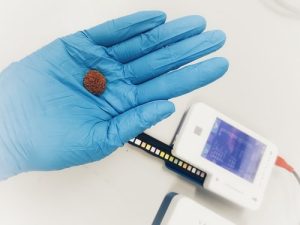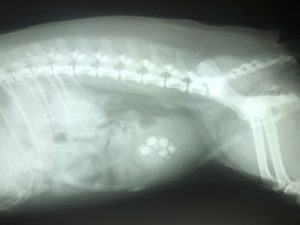Dogs with urolithiasis have stones in their urinary tract. This could be in the kidneys, ureters, bladder or urethra. 0.3-2.8% of dogs get urolithiasis. It can happen in any dog, but it’s more common in females, certain breeds and dogs with other illnesses. Untreated urolithiasis can result in life-threatening blockages of the urinary tract.
Urolithiasis in dogs causes bladder irritation, infection and urinary tract blockages (blocked bladder). Uroliths include everything from tiny particles, like sand, to large single stones. And often both together. There are multiple treatment options, depending on the type of stone and location, but the condition often recurs. Always call a vet if your dog shows signs of difficulty or discomfort peeing or has blood in their urine.
Overview
What is urolithiasis in dogs?
Urolithiasis is the formation of hard rock-like material from minerals in urine. These minerals originally come from the food your dog eats. Normal urine contains minerals, including calcium, phosphorus, magnesium, chloride and sodium.
- Bladder infections, diet, genetic (inherited) disorders, liver disease and previous bladder surgery can all trigger increased crystal formation from minerals in urine.
- Crystals irritate the bladder wall, making it release thick mucus for protection.
- The mucus and crystals stick together, getting bigger and harder over time to form stones.
- Stones can take anything from a few weeks to months to form.
- There are different types of minerals that cause different types of stones.
- 20-40% of dogs treated for urolithiasis suffer recurrence within 1 year, and almost 50% within 3 years.
- Urolithiasis in dogs is a general term. Stones in different parts of the urinary tract also have specific names, for example, nephrolithiasis (kidney stones), cystolithiasis (bladder stones).
There are 4 types of stones in dogs:
- Struvite
- Calcium oxalate
- Urate
- Cystine

- Bladder stone
Causes:
- Infection – bacterial release chemicals that reduce acidity of urine, encouraging stone formation
- Diet
- Genetics
- Foreign material in bladder (sutures from previous bladder surgery)
- Lack of exercise and not drinking enough water
- Certain medications – allopurinol prevents one type of stone but can trigger another in some patients
Symptoms
Symptoms of urolithiasis in dogs
The symptoms of urolithiasis in dogs will vary depending on the location of the stone(s).
Common symptoms:
- Difficulty peeing – repeated squatting, passing small amounts, vocalising
- Blood in urine
- Becoming dull or depressed
- Eating less
- Vomiting
- Having a tense, painful tummy
- Fever
Risk
Dogs at a higher risk of urolithiasis
- Belonging to certain breeds: Miniature Schnauzer, Pekingese, Yorkshire Terrier, German Shepherd, Welsh Corgi, English Bulldog, Dalmatian, Beagle, Dachshund, Basset Hound, Miniature Poodle, and Scottish Terrier
- Eating an unbalanced diet: food very high in protein and certain minerals – calcium, magnesium, phosphorus
- Having other illnesses: liver disease, diabetes, liver shunts
- Not drinking enough water or getting enough exercise
- Previously having had urolithiasis
- Previous bladder surgery (possibly stone removal)
Complications of urolithiasis
- Blocked bladder, especially male dogs with a narrower urethra
- Burst bladder
- Kidney damage, even kidney failure
- Sepsis
Will my other dog(s) get urolithiasis?
Urolithiasis affects individual dogs and cannot spread between dogs or from dogs to humans. However, dogs in the same household with the same risk factors (breed, diet, etc) will have the same risk of getting the illness.
Diagnosis
How do vets diagnose urolithiasis in dogs?
To begin with, urolithiasis may look like a simple urinary tract infection. Your vet will need to do further tests to confirm the presence of urolithiasis.
Tests include:
- Urine tests: testing urine components with a dipstick; looking for cells and crystals under a microscope
- Abdominal palpation: vets may be able to feel larger stones in the bladder just by feeling the tummy of smaller dogs
- X-ray: some stones will show up on standard x-rays or can be outlined with contrast dye
- Ultrasound: urate and cystine
- Blood tests: general health and specific causes of urolithiasis
- Urine culture: checking which bacteria are causing any infection
- Endoscopy: exploring the urinary tract with a flexible camera

- Dog x-ray with bladder stones
Crystals form in urine left around for any length of time and sometimes even in fresh or refrigerated samples. Any sample you take to your vet for testing must be as fresh as possible. Finding crystals in urine is not the same as having urolithiasis. But it may confirm the need for further tests if your dog has symptoms.
Vet treatment
What’s the treatment for urolithiasis in dogs?
Some stones can be dissolved using special diets. Others are too large, undissolvable or require immediate removal after causing a blockage. All dogs with urolithiasis must be encouraged to drink more while treating the illness and to reduce the risk of it coming back.
Treatments include:
- Special diets: to alter the acidity and chemical make-up of your dog’s urine; can dissolve some stones, either completely or to reduce size and number prior to surgery
- Antibiotics: to treat infection associated with stones
- Medicine to control acidity of urine: helps reduce stone formation or encourages dissolving
Procedures and operations:
Flushing
- For small stones in the bladder and urethra
- Carried out while your dog is asleep under a general anaesthetic
- A catheter (narrow sterile tube) is passed through the urethra towards the bladder; the bladder is filled with sterile saline; after stirring things up a bit, the vet squeezes the bladder empty
- Limited to small stones
Endoscopy (cystoscopy) removal
- Usually carried out under heavy sedation or a general anaesthetic
- Endoscope (camera) passed into bladder through urethra or via keyhole surgery. Individual stones picked picked up and removed in pincers or a mini ‘basket’, or flushed out of bladder
- Limited to small stones
Surgery
- Carried out under a general anaesthetic
- An operation to open the tummy and bladder and remove stones directly
- Likely option where large stones causing blockage
Stents
- Stents are small mesh tubes used to hold open a vessel
- Used for upper urinary tract blockages – the ureters
- Placed via keyhole surgery and an endoscope from the kidney
- May be passed up from the urethra in female dogs
- Holds the ureter open to allow urine to get past a blockage
Laser treatment
- Breaking up bladder stones using a laser
- Only available in specialist hospitals
- Works for all types of stones
- Carried out via cystoscopy – unsuitable for small male dogs with a narrow urethra
Treatment options for types of urolithiasis
- Struvite is dissolved using a special diet like Hills Prescription Diet s/d or c/d; antibiotics throughout treatment due to ongoing live bacterial release from dissolving stones; removal if large or causing blockage
- Urate or Cystine: Hills Prescription Diet u/d may help to reduce size before removal
- Calcium oxalate cannot be dissolved
Home treatment
How to care for a dog with urolithiasis at home
There are no home cures for urolithiasis. Dogs with stones in their urinary tracts risk developing life-threatening blockages. Male dogs and small dogs are at most immediate risk for this.
If your dog has had sedation, general anaesthesia, endoscope procedure, and/or surgery, follow your vet’s directions for their specific care.
You can help your dog’s recovery by:
- Increasing water intake: continuing to encourage them to drink
- Feeding the special diet as advised by your vet with no other foods or treats
- Giving any medication at the times and doses prescribed by your vet
Prevention
How to prevent your dog getting urolithiasis
Some dogs have an inherited risk of stones. If we know the risks, we can ensure they have a special diet to prevent stones from forming. It’s one of the many reasons that it’s a good idea to research the breed before you bring a puppy or dog home for the first time.
General tips for reducing risks include:
- Ensuring your dog always has lots of fresh water to drink
- Maintaining them at a healthy body weight and condition
- Keeping your dog active
- Feeding a balanced, healthy diet
- Ask a vet before giving your dog mineral or vitamin supplements
Preventing urolithiasis from coming back again:
- Treating underlying illness
- Feeding wet food and/or ideally a special prescription diet
- Supplements for bladder health may help reduce the risk of stone formation
- Medicine to prevent stone formation – for example, allopurinol to prevent urate stones
Always talk to your vet before giving your dog a special diet or supplements.
When to worry
When to worry
Seek help from a vet immediately if your dog is:
- Is unable to pass any urine, despite repeated attempts
- Has a suspected stone and starts vomiting
- Has a tense, painful or distended tummy
Call a vet if your dog is:
- Squatting more than usual
- Passing smaller amounts if urine than usual
- Has cloudy-looking or blood in their urine
- Is asking out more often
Joii can help with advice on:
- Recognising signs if urolithiasis
- Suitable diets for dogs of all ages and lifestyles
- Encouraging your dog to drink
- Safe and effective urinary supplements








